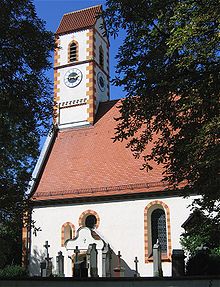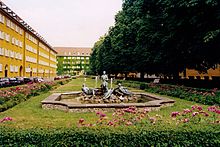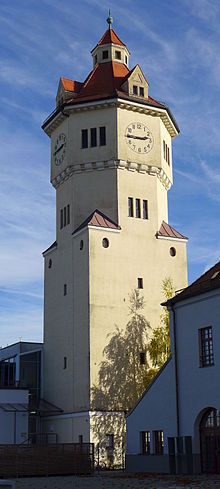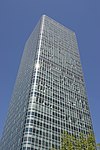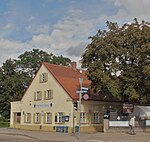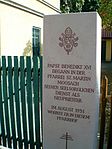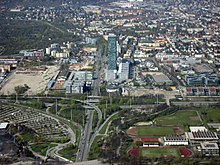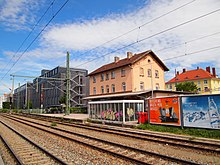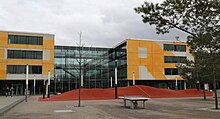Moosach (Munich)
|
Moosach
State capital Munich
Coordinates: 48 ° 11 ′ 0 ″ N , 11 ° 31 ′ 0 ″ E
|
|
|---|---|
| Area : | 11.09 km² |
| Residents : | 54,872 (Dec. 31, 2019) |
| Population density : | 4,946 inhabitants / km² |
| Postcodes : | 80637, 80638, 80992, 80993, 80997 |
| Area code : | 089 |
|
Location of the city district 10 in Munich
|
|
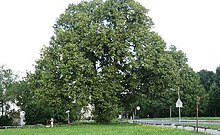
Moosach is the city district 10 of the Bavarian capital Munich .
The city district is divided into the districts Hartmannshofen, Nederling , Borstei and Olympia-Pressestadt . The former village owes its name to the Moosach , an almost 60 km long left tributary of the Isar . The original course of the Moosach is now called Feldmochinger Mühlbach and has been diverted from the Würm Canal since the regulatory measures at Oberschleißheim .
location
The city district is located in the northwest of the city and extends from Landshuter Allee (Mittlerer Ring) in the east over the marshalling yard in the north and Waldhornstrasse in the west to the Westfriedhof in the south.
Neighboring districts are Feldmoching-Hasenbergl in the north, Milbertshofen-Am Hart in the east, Neuhausen-Nymphenburg in the south, Pasing-Obermenzing in the southwest and Allach-Untermenzing in the west.
History and structure
An almost uninterrupted chain of prehistoric finds allows the conclusion to be drawn that there was continuous settlement from 4000 years to the younger Stone Age. Moosach is one of the oldest places around or in Munich. The first documentary mention dates from June 4, 807. The St. Martin's Church in Moosach was built before 1315 . The Röth linden tree , Munich's oldest tree, was planted around 1700 .
In 1717, Elector Max Emanuel built the pheasantry, originally a forester's house for rearing pheasants , today a beer garden with 1500 seats in the self-service area and another 200 seats in the serviced area. In the 1960s, the Free State of Bavaria converted the area into Hartmannshofer Park .
In 1818, Nederling came to Moosach as part of the formation of the community.
In 1906, construction of the Moosach gasworks on Dachauer Strasse began. The place Moosach was an independent municipality until June 30, 1913 and when it was incorporated it became part of the 28th district of Neuhausen-Moosach , which also included the Gern part of the former municipality of Nymphenburg . When the urban area was reorganized, with effect from May 1, 1996, all districts of Neuhausen and Nymphenburg were added to the urban district of the same name 9 Neuhausen-Nymphenburg . Thus, the city district 10 now essentially comprises the area of the former municipality of Moosach, which, according to the last list of localities before the incorporation of 1904, comprised an area of 1184.44 hectares .
From (depending on the source: August 25, 1941 or) December 17, 1942 to March 13, 1945, the Munich-Moosach labor education camp was located in the district . There are said to have been 400 to 500 prisoners in the four barracks.
For Moosach, the Pelkovenstrasse played a major role as a salt and trade route . General Eisenhower held several military parades there in 1945/46 . He spent the night in the Netzervilla.
The urban development in Moosach essentially only began after the Second World War. Single-family houses, terraced houses and smaller apartment buildings (privately financed, publicly funded and cooperative) make Moosach today largely a district with lower residential density than can be found in the inner city areas. Due to the intensive development of the building areas that are still available, the population density is also increasing significantly in the Moosach areas. To the east, the buildings with the Olympic Press City and residential complexes from the interwar period are concentrated . The model settlement Borstei built between 1924 and 1930 in the southeast corner of the district is remarkable . From 1951 the Trinkl-Siedlung was built , illegally erected black buildings at the time.
The oldest church in Moosach is located in Pelkovenstraße and next to it is the former rectory . The church belongs to the parish of St. Martin . The former rectory is now rented. In addition, a stele in honor of Pope Benedict XVI. who took up his first position as a new priest in 1951 as Joseph Aloisius Ratzinger in St. Martin and lived in the rectory.
The ev.-luth. The Munich Heilig-Geist parish looks after many believers in Moosach who gather in three places of worship: Heilig-Geist-Kirche, Olympiakirche and Magdalenenkirche.
On Pelkovenstraße, the main axis of the old Moosach, the oldest inns in the district mark the expansion of the place into the 19th century. The Alte Wirt , also one of the oldest inns in Munich, is on the corner of Dachauer Straße and the Gasthaus Spiegl at the other end of the old Moosach on the corner of Feldmochinger Straße.
In 1972, the Olympic Press City for the Olympic Games was built west of Landshuter Allee . The high-rise building there at Riesstrasse 82 is currently the twelfth tallest building in Munich at 83 meters. The Uptown Munich high-rise complex was built from 2001 to 2004 , at 146 meters the second tallest building in the city after the Olympic Tower .
In 2020, the Moosach bus depot will be built in the district .
With the move of members of the middle class to Moosach, where traditionally small traders, workers and ordinary employees lived, the social structure is now more balanced. After the position in the job, employees and civil servants dominate among the employed. The household structure is still clearly shaped by families with children; One-person households are accordingly underrepresented.
Jobs are mainly in manufacturing (automotive and mechanical engineering, textile and clothing, and chemicals), trade (compressed on "Moosacherstrasse Stachus" at the Dachau - , Bauberger- , Bunzlauer- and Pelkovenstraße , the Olympia shopping center and neighborhood centers Mona and Meile Moosach ) as well as in the service sector .
Uptown Munich , tallest skyscraper in the city
Infrastructure
Street
With the Mittlerer Ring and Moosacher Straße and their feeders, Triebstraße, Dachauer Straße and Von-Kahr-Straße , the district is cut through or affected by several main roads with significant through traffic. The Kapuzinerhölzl and Hartmannshofer Wald protected landscape areas in the district , some allotments and the Westfriedhof provide a certain ecological balance .
train
Moosach is on the Munich – Regensburg railway line and is served by the S1 line of the Munich S-Bahn at Munich-Moosach station. Since November 22, 1930, the Munich district has been connected to the city center by today's tram lines 20 and N20. With the underground lines U1 and U3 at the Olympia shopping center , Moosach is connected to the Munich underground network . In December 2010, the continuation of the U3 via another underground station at Moosacher St-Martins-Platz to Moosacher Bahnhof was completed. In order to make the area around the "Moosacher Stachus" more attractive, the surface was redesigned after the completion of the subway construction and the associated back-extension of the tram line , which temporarily ended at Pelkovenstraße from 2004 to December 2008.
Altogether there are 38 stops in Moosach for two underground, one S-Bahn, two trams (including one night tram) and nine bus routes.
culture and education
In September 2006, the Christian children and youth organization opened the children and youth center Die Arche . At the moment 40 to 60 children between the ages of five and twelve are cared for in a temporary building on Brieger Strasse . Facilities for young people are also the parish of St. Martin and the Mooskito youth club and the boomerang children's and youth club at Pelkovenstraße 128.
The Magdalenenkirche is in Ohlauer Straße 16 , the Church of St. Mauritius is in Templestraße 5 , in Lechelstraße 54 is the Church of St. Raphael , in Gubestraße 4 the Heilig-Geist-Kirche , in Treibstraße 3 the Christian free church Moosach as well at Riesstrasse 102 the Ethiopian Orthodox Church .
In 2007 the Riesstrasse vocational school opened .
The Pelkovenschlössl cultural and community center is the central location for educational and cultural events.
The Kunsttreff-Moosach is located at Donauwörther Straße 51.
Sports
- PSV Munich , Franz-Mader-Strasse 11
- TSV Moosach-Hartmannshofen , Lechelstr. 35 (founded in 1903 as a sports club Germania Moosach)
- FC Olympia Moosach, Saarlouiser Strasse 86
Green spaces
Architectural monuments
The area around Moosacher St.-Martins-Platz represents the center of the former center of Moosach with the old parish church and the castle (" Pelkovenschlössl ") and is under ensemble protection (E-1-62-000-37).
See also: List of architectural monuments in Munich / Moosach
politics
The Moosach district committee was last elected on March 15, 2020. The distribution of seats is as follows: SPD 7, CSU 7, Greens 7, FW 2, AfD 1 and FDP 1. Of the 37,257 residents of Moosach who are entitled to vote, 16,586 exercised their right to vote, making the turnout 44.5 percent.
Companies
statistics

(As of December 31, residents with main residence)
| year | Residents | including foreigners | Inhabitants per km² |
|---|---|---|---|
| 2000 | 45,538 | 10,772 (23.7%) | 4,108 |
| 2001 | 46.174 | 11,011 (23.8%) | 4.164 |
| 2002 | 46,333 | 11,054 (23.9%) | 4.179 |
| 2003 | 46,546 | 11,104 (23.9%) | 4,198 |
| 2004 | 46,856 | 11,442 (24.4%) | 4,225 |
| 2005 | 47.198 | 11,758 (24.9%) | 4,255 |
| 2006 | 47,754 | 11,942 (25.0%) | 4,300 |
| 2007 | 48,306 | 12,192 (25.2%) | 4,354 |
| 2008 | 48,451 | 12,352 (25.5%) | 4,367 |
| 2009 | 48,692 | 12,679 (26.0%) | 4,389 |
| 2010 | 48,421 | 12,567 (26.0%) | 4,365 |
| 2011 | 49,384 | 13,418 (27.2%) | 4,452 |
| 2012 | 50,253 | 14,038 (27.9%) | 4,530 |
| 2013 | 51,537 | 14,805 (28.7%) | 4,646 |
| 2014 | 52,657 | 15,606 (29.6%) | 4,747 |
| 2015 | 53,261 | 16,120 (30.3%) | 4,801 |
| 2016 | 53,859 | 16,615 (30.8%) | 4,855 |
| 2017 | 53,662 | 16,602 (30.9%) | 4,837 |
| 2018 | 54,223 | 17,072 (31.5%) | 4,888 |
| 2019 | 54,872 | 17,687 (32.2%) | 4,946 |
Source with further data
| Elementary schools | 4th |
| Secondary schools | 2 |
| Realschulen | 1 |
| high school | 1 |
| Vocational schools | 2 |
| Kindergartens | 19th |
| Day nurseries | 1 |
| Day care centers | 7th |
| Cooperation institutions | 1 |
| Leisure homes | 2 |
| playgrounds | 27 |
| Social bourgeoisie | 1 |
| Elderly and service center | 1 |
| District library | 1 |
| Parks, green spaces | 51 (61 ha) |
| Nursing homes | 2 |
Personalities from Moosach
- Johannes Kuen (1606–1675), Baroque poet
- Malachias Lachmayr (born September 20, 1626; † 1688), abbot of the Raitenhaslach monastery
- Georg Patzenhofer (1815–1873), brought Munich beer to Berlin in 1855
- Faris Al-Sultan (* 1978), triathlete
literature
- Volker D. Laturell : Moosach. Volume 1: From the beginning to 1800 . Tins, Munich 1980.
- Volker D. Laturell: Moosach. Volume 2: From 1800 to the present . Tins, Munich 1985.
- Volker D. Laturel, Mooseder Georg: Moosach: Past and present . ISBN 3880347425 .
- Volker D. Laturell: Moosach - the district book for the 10th district with the districts Borstei, Hartmannshofen, Moosach, Nederling and Olympia-Pressestadt . Bavarica-Verlag Bauer, Munich 2001, ISBN 3-935440-02-2 .
Web links
- History of Moosach
- Moosach district - state capital Munich
- City district and district committee 10 Moosach - City of Munich
Individual evidence
- ↑ Population status December 2019 (PDF). Retrieved February 22, 2020.
- ↑ History, dates, facts. In: sueddeutsche.de. October 25, 2011, accessed March 11, 2018 .
- ↑ http://www.naturorte.de/hartmannshofer-park
- ^ Wilhelm Volkert (ed.): Handbook of Bavarian offices, communities and courts 1799–1980 . CH Beck, Munich 1983, ISBN 3-406-09669-7 , p. 601 .
- ↑ https://www.bundesarchiv.de/zwangsarbeit/haftstaetten/index.php?action=2.2&tab=7&id=100000087
- ↑ https://www.sueddeutsche.de/muenchen/moosach-spurlos-verschwunden-1.4803107
- ↑ Moosach · From teaching colony on the lower village to the station. In: Münchner Wochenanzeiger. 3rd October 2012.
- ↑ https://www.sueddeutsche.de/muenchen/moosach-alles-auf-anfang-1.4513879
- ↑ Heinrich Habel, Helga Hiemen: Munich . In: Bavarian State Office for Monument Preservation (ed.): Monuments in Bavaria - administrative districts . 3rd improved and enlarged edition. tape I.1 . R. Oldenbourg Verlag, Munich 1991, ISBN 3-486-52399-6 .
- ↑ a b c Election of the District Committee - District 10 - Moosach . State capital Munich. Retrieved May 9, 2020.
- ^ Archive district information . State capital Munich. Retrieved January 6, 2019.
- ^ Information sheet from the City of Munich from October 15, 2007

